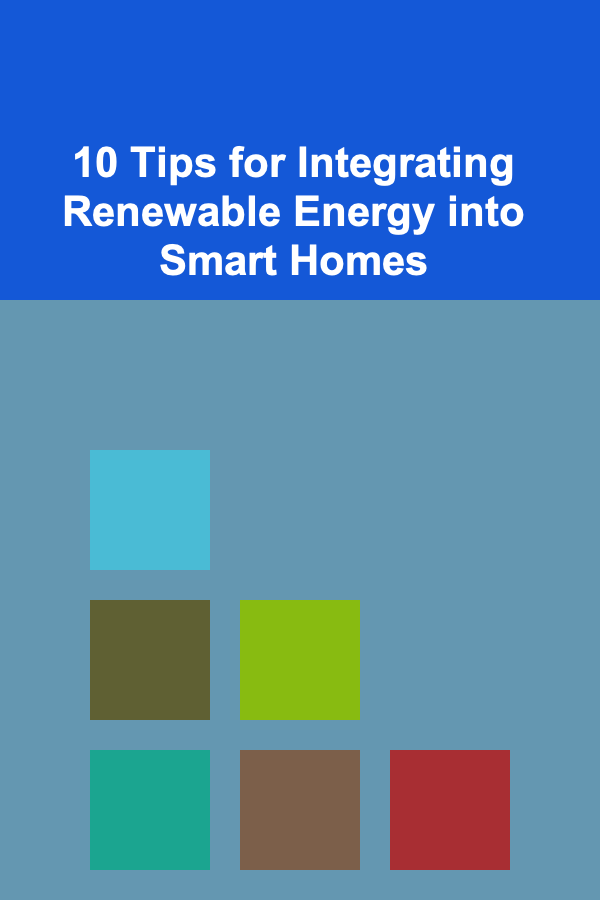
10 Tips for Integrating Renewable Energy into Smart Homes
ebook include PDF & Audio bundle (Micro Guide)
$12.99$10.99
Limited Time Offer! Order within the next:

The future of home energy is rapidly changing, with a shift towards more sustainable and efficient solutions. As we continue to confront climate change and rising energy demands, the integration of renewable energy into our homes has become more critical than ever. At the intersection of energy and technology, smart homes are uniquely positioned to benefit from renewable energy sources. These homes, equipped with intelligent systems that can automate and optimize energy use, are becoming the blueprint for a greener, more sustainable future.
In this article, we will explore 10 tips for integrating renewable energy into smart homes. These tips will help you harness the power of renewable energy, reduce your carbon footprint, and make your home both smarter and more energy-efficient. Whether you are looking to install solar panels, wind turbines, or explore other green energy solutions, the following guidelines will give you the insights you need.
Conduct an Energy Audit Before Making Any Changes
The first step in integrating renewable energy into your smart home is to understand your current energy consumption. Conducting an energy audit can give you a clear picture of how much energy your home uses, where it's being used, and which areas need improvement. An energy audit will help you make informed decisions on which renewable energy systems to install and how to optimize them.
An energy audit typically involves evaluating your home's insulation, windows, appliances, and lighting. It can also include testing the efficiency of your HVAC system, water heater, and other major energy-consuming devices. Once you know where your home's energy weaknesses lie, you can take steps to reduce consumption, making your renewable energy systems more effective.
Why it matters:
- Reduces unnecessary energy consumption.
- Helps design a more efficient renewable energy system.
- Allows for better use of smart home devices for energy optimization.
Install Solar Panels for Clean, Renewable Energy
Solar power is one of the most common and effective renewable energy solutions for smart homes. By installing solar panels on your roof, you can harness the sun's energy to power your home. Solar energy is both abundant and clean, making it an ideal choice for anyone looking to reduce their dependence on fossil fuels.
Smart homes can use solar panels in combination with energy storage systems (like batteries) to ensure a constant supply of power. Solar panels can generate electricity during the day, while batteries store excess energy to be used at night or during cloudy periods.
Key considerations:
- Ensure your roof has optimal sun exposure.
- Consider battery storage systems to maximize the use of solar power.
- Integrate smart solar systems with your home automation setup for optimal performance.
Incorporate Energy Storage Solutions
While solar panels can generate energy, energy storage solutions such as home batteries are essential for ensuring that this energy can be used when the sun isn't shining. Systems like the Tesla Powerwall , LG Chem RESU , or Sonnen can store excess energy generated by solar panels and release it when needed.
Energy storage allows your smart home to operate autonomously from the grid, or at least reduce reliance on external energy sources. When coupled with smart home systems, these batteries can be monitored and controlled remotely, ensuring that energy is used efficiently.
Benefits of energy storage:
- Enables off-grid living or reduces reliance on the grid.
- Stores excess energy for use during peak hours.
- Allows integration with smart home energy management systems for automated usage.
Utilize Smart Thermostats to Optimize Energy Use
Smart thermostats, such as the Nest Thermostat or Ecobee, are pivotal in controlling the heating and cooling of your home efficiently. These devices learn your behavior over time and adjust temperature settings accordingly to reduce energy waste. They can also be programmed to optimize energy use based on your home's renewable energy production.
For example, during the day when your solar panels are generating energy, a smart thermostat can pre-cool or pre-heat your home, ensuring that you don't use energy when it's most expensive or inefficient.
How it helps:
- Reduces heating and cooling energy consumption.
- Integrates with renewable energy sources for smarter energy usage.
- Allows remote control and scheduling through apps for greater convenience.
Switch to LED Lighting and Smart Bulbs
Switching to LED lighting is one of the easiest and most effective ways to reduce energy consumption. LED lights use significantly less energy compared to traditional incandescent bulbs and last longer, making them a more sustainable option. In addition, integrating smart bulbs , such as Philips Hue or LIFX, into your home can allow you to control your lights remotely and program them to operate at optimal times.
For example, smart lighting systems can be programmed to turn off when you're not in the room or adjust the brightness according to the time of day or the amount of natural light in the room.
Why it's effective:
- Reduces overall electricity consumption.
- Allows remote control and scheduling for energy optimization.
- Easily integrated with home automation systems.
Install Smart Energy Meters and Monitoring Systems
A smart energy meter is an essential tool for managing energy consumption in a renewable energy-powered home. These devices allow you to monitor your home's energy usage in real time and identify patterns of energy waste. You can then adjust your consumption to align with the production of renewable energy, such as solar or wind, for maximum efficiency.
Smart meters can be integrated into your home's automation system, allowing for automated control of appliances, lights, and heating/cooling systems based on your energy usage and production.
How it benefits you:
- Provides insights into your energy usage patterns.
- Helps track energy savings and renewable energy production.
- Facilitates the integration of renewable energy into smart home systems.
Incorporate Wind Turbines for Supplemental Power
If you live in an area with consistent wind, a residential wind turbine can be a great addition to your renewable energy strategy. Wind turbines can complement solar power systems by generating energy during windy periods, especially in the winter when solar power is less effective.
Wind turbines can generate enough energy to power several homes, and they work especially well when integrated into a smart home system, as they can automatically supply energy to different parts of the home based on the energy needs.
Key considerations:
- Ensure you have adequate wind conditions to justify installation.
- Wind turbines may require a larger investment compared to solar panels.
- Can work in tandem with solar systems for year-round energy production.
Adopt Smart Appliances and Energy-Efficient Technologies
One of the best ways to reduce energy consumption in a smart home is by investing in smart appliances and energy-efficient technologies. Smart appliances like washing machines, refrigerators, and dishwashers can be programmed to operate during off-peak hours, ensuring that they run when there is excess renewable energy available.
Additionally, choosing appliances with the highest energy ratings, such as those with the Energy Star label, ensures that your energy consumption remains as low as possible.
How to integrate:
- Replace old appliances with energy-efficient smart models.
- Program appliances to run during periods of high renewable energy production.
- Monitor appliance energy use through smart home apps for better control.
Create a Smart Energy Management System
A Smart Energy Management System (SEMS) can be the brain of your home's renewable energy infrastructure. This system allows you to track, monitor, and optimize the use of your renewable energy sources. It can integrate with solar panels, wind turbines, battery storage, and appliances, creating a seamless energy ecosystem within your home.
With SEMS, you can automate the entire process of energy consumption, ensuring that renewable energy is used when available and grid power is only used when absolutely necessary. Many SEMS solutions are compatible with virtual assistants like Amazon Alexa or Google Assistant, allowing you to control energy settings through voice commands.
Key benefits:
- Provides a central control system for all energy-related devices in your home.
- Integrates renewable energy sources for efficient usage.
- Offers real-time energy tracking and alerts.
Focus on Sustainability in Home Design
Finally, when integrating renewable energy into your smart home, it's essential to focus on sustainability in your home's overall design. Incorporating passive solar design elements, such as properly oriented windows, thermal insulation, and reflective roofing materials, can reduce the amount of energy needed for heating and cooling.
Moreover, using sustainable materials like recycled or low-impact building materials can reduce the environmental impact of your home's construction, making it even more eco-friendly.
Sustainable design considerations:
- Optimize your home's design to make the most of natural light and ventilation.
- Use energy-efficient windows, insulation, and roofing materials.
- Incorporate green building materials to further reduce your home's carbon footprint.
Conclusion
Integrating renewable energy into smart homes is a crucial step in creating a sustainable, energy-efficient future. With the right combination of renewable energy sources, smart technologies, and efficient home design, you can significantly reduce your home's energy consumption and lower your environmental impact.
By following these 10 tips, you can ensure that your smart home is not only more intelligent but also more environmentally responsible. As technology continues to evolve, the possibilities for renewable energy integration will only grow, making it easier than ever to live sustainably without sacrificing convenience or comfort.
Reading More From Our Other Websites
- [Home Soundproofing 101] How to Create a Professional Home Theater with Soundproofing Tips
- [Organization Tip 101] How to Involve Kids in Organizing Your Yard Sale
- [Organization Tip 101] How to Capture Special Moments Beyond the Wedding Day
- [Personal Financial Planning 101] How to Build a Resilient Financial Future by Integrating Insights from Personal Finance Books into Your Daily Money Habits
- [Reading Habit Tip 101] The Science Behind Reading: Why It Improves Memory and Critical Thinking
- [Organization Tip 101] How to Implement a Referral Program for New Tenants
- [Organization Tip 101] Best Organization Tools for Writers and Authors
- [Home Family Activity 101] How to Experiment with Homemade Slime Recipes for Sensory Play and STEM Learning
- [Organization Tip 101] How to Categorize Vintage vs. Modern Jewelry Effectively
- [Simple Life Tip 101] Best Simple Recipes Using Only One Pot and Five Ingredients

Creative Solutions for Saving Money on Home Entertainment Systems
Read More
How to Groom Your Pet at Home Without Stress
Read More
How to Profit from Deep Learning in the Freelance Market
Read More
How to Use Public Relations Expertise to Make Money
Read More
How to Find Remote Work Opportunities
Read More
How to Claim Education Tax Credits for Online Courses and Programs
Read MoreOther Products

Creative Solutions for Saving Money on Home Entertainment Systems
Read More
How to Groom Your Pet at Home Without Stress
Read More
How to Profit from Deep Learning in the Freelance Market
Read More
How to Use Public Relations Expertise to Make Money
Read More
How to Find Remote Work Opportunities
Read More